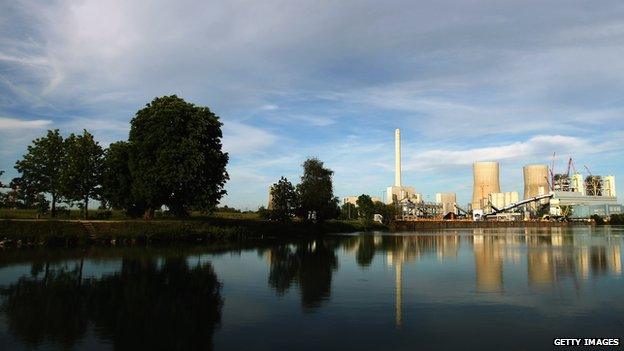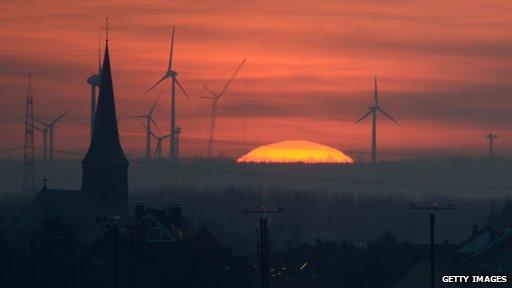Green energy on the back foot after carbon trading blow
- Published
- comments

Coal-fired electricity generation has seen a resurgence in Europe over the past two years
It's been a bad week for efforts to develop green energy around the world.
A new report, external from the International Energy Agency (IEA) says that progress towards carbon-free energy production has basically stalled.
"Despite much talk by world leaders," said IEA executive director, Maria van der Hoeven, "and despite a boom in renewable energy over the last decade, the average unit of energy produced today is basically as dirty as it was 20 years ago."
The IEA uses a complex calculation called the carbon intensity index to show how much CO2 is emitted to provide a given unit of energy.
The index stood at 2.39 tonnes of CO2 per tonne of oil in 1990. By 2010, it has shrunk fractionally to 2.37 tonnes.
Back to black
The major reason for such a small reduction of that period, according to the IEA, was the resurgence, external of coal. And it continues to grow. Globally, coal-fired electricity generation rose by an estimated 6% from 2010 to 2012 , faster than non-fossil energy.
The major growth in coal came from developing economies, with China accounting for 46% of global coal demand in 2011.
But it's not just them.
Europe, the region that likes to think of itself as perhaps the greenest in the world, has also seen a return to coal in the last couple of years. While the US has turned, external to shale gas, Europeans have once again embraced the black stuff, as the cost, external of coal has plummeted.
However, it is not all bad news for the green sector. Renewables such as solar and wind have boomed in 2011 and 2012, perhaps driven by government spending.
They accounted for 19% of global electricity generation in 2011 which according to the report is "broadly on track to meet a 2C scenario by 2020" for a globally altered climate.
Electric vehicle sales have doubled (still a measly 110,000) while hybrid vehicles have finally broken the one million sales mark.
But turning this oil tanker (perhaps coal carrier is a better metaphor?) is not going to be easy.
And efforts will not have been helped by a vote in the European Parliament that rejected an attempt by the Commission to prop up the extremely ailing EU carbon market.

Carbon trading is seen as critical for making green energy more affordable
The EU Emissions Trading Scheme (ETS, external) has been seen as the world's best attempt to cut carbon by means of cap and trade. Essentially, 12,000 or so electricity generators and industrial heavy users of energy have had their emissions limited by EU law. The development of this market was seen as critical to both cutting emissions and driving investment in green energy.
But too many, external allowances were issued over the past few years - and the market price collapsed. The Commission attempted to rectify this by reducing the number of allowances due to issued in the next two years, a proposal known as backloading, external.
The Parliament though wouldn't wear it. Many MEPs held to the view that the collapsing carbon price was an accurate reflection of the real economy.
Some environmental campaigners have also welcomed the backloading breakdown. They argue that the market hasn't worked, external as it essentially has become a means of avoiding real carbon cuts by paying someone else to do them.
"We believe the failed backloading vote points to the fact that we need alternative tools - direct, ambitious, just regulatory policies," said Hannah Mowat from Fern, a NGO that has been working, external on carbon issues for a decade.
"We are now trying to galvanize support around more effective tools to achieve emissions reductions. " she added.
There is now going to be a serious amount of head-scratching among European academics and politicians on the best ways forward for green energy.
Follow Matt on Twitter, external.